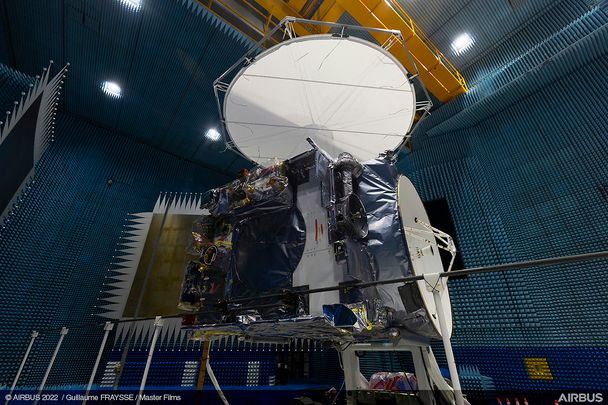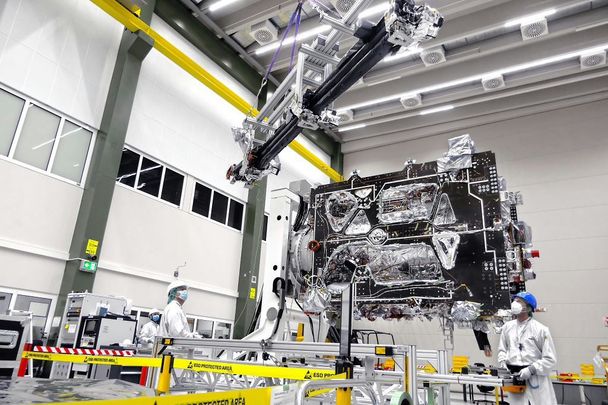Guiding JUICE to Jupiter – learn about the technical mountains we had to climb

Europe’s Jupiter Icy Moon Explorer space probe, or JUICE for short, is embarking on a 5 billion kilometre trip to Jupiter to search for water on several of the gas giant’s icy moons.

This phenomenal endeavour, led by the European Space Agency, is powered by Airbus technology. Our engineers have rarely faced a greater challenge than enabling such a journey. The JUICE probe will encounter extreme temperatures, intense radiation and decreasing solar energy during its 5 billion kilometre journey. Being self-sufficient in energy generation and storage is key to the mission’s success.
Power generators the size of a badminton court
Operating in the outer reaches of the solar system, far from the Sun, JUICE uses large solar arrays around the size of a badminton court – 85 m2 — to generate energy.
Divided into ten panels each measuring 2.5x3.5m, JUICE’s solar wings will produce energy during its long journey to Jupiter. The solar energy will enable JUICE to carry out 35 fly-bys of Europa, Ganymede and Callisto and generate the 800 watts of power needed to operate the ten scientific instruments on board.
Airbus manufactured the panel structures and the deployment mechanism. Both have been subjected to robust testing to ensure they are ready to face the extremes of temperature the mission will encounter, from -230°C at Jupiter up to +110°C during Venus flyby, the hottest surface of the spacecraft reaching +250°C.

Blowing hot and cold
JUICE’s thermal control system is designed to minimise the impact of the external environment on the spacecraft, through the use of high efficiency Multi-Layer Insulation (MLI). MLI will moderate the external temperature during the spacecraft's closest approach to the Sun. It must also limit heat leakage in the cold Jupiter environment, in order to minimise demand for power from the spacecraft's heaters while its instruments are operating. Managing power will be a crucial factor throughout JUICE’s mission, given the limited power generated by the spacecraft's solar panels. Jupiter is so far from the Sun that the solar energy it receives is 25 times lower than on Earth.
Aiming for utmost accuracy
With five billion kilometres to cover throughout the mission, four fly-bys to perform and 30 observation overflights, the complexity of the JUICE mission requires accurate navigation. The conventional technique is to improve standard radiofrequency navigation with a camera to take pictures of various objects (planets, stars). These images are returned to Earth for a cross-check. A ground team then tracks and plots the probe’s precise trajectory, aiming the spacecraft’s instruments toward areas of interest for science.
However this approach is not ideal for the JUICE mission. This is for two reasons: the true position of the moons during their orbit around Jupiter is not known with sufficient accuracy for ground teams to plot a course and it takes JUICE too long to communicate with Earth. A round-trip radio signal takes about one hour and 40 minutes, which prevents the ground team from adapting the probe’s trajectory before flying by the moons.
This is why the "EAGLE" autonomous navigation technology which uses images taken by the ‘Navcam’ camera in real-time was developed. Instead of sending pictures of Jupiter’s moons back to the team on Earth to aim the instruments, the JUICE NavCam is able to process them on board, thanks to algorithms based on detection of the edge of the moons. With this information, JUICE can independently refine the viewing angle of its instruments.
Endless innovation
One of Jupiter's mysteries is the planet’s enormous magnetic field. The magnetosphere rotates with the planet, capturing swarms of charged particles. This fast rotation creates a natural particle accelerator, causing the particles to release radio waves which can reach Jupiter’s icy moons.
It’s hoped that by investigating the moons’ electrical and magnetic environment, the JUICE mission can increase our knowledge of how this harsh environment 740 million kilometres from the Sun shaped, and continues to shape, the conditions on their surface.
The sensitive instruments on board the probe, including a magnetometer, are designed to record data about Jupiter’s magnetic field. However, to make the measurements as accurate as possible, JUICE must ensure that it is ‘squeaky clean’, in that its own presence and emissions do not disturb the instruments. To produce such a ‘clean’ spacecraft was a huge challenge. In order to reduce electric and magnetic emissions and electrostatic interference with the instruments, most of the electronics are installed in two special housings on each side of the probe that help seal in emissions. Additionally, these housings protect the equipment itself from space radiation.
A ten-metre long arm, named Magboom, will keep the most sensitive sensors away from the probe and any electromagnetic interference it may generate while taking measurements.
Airbus engineers have also designed a unique layout for the 23,560 solar cells in JUICE's solar panels to minimise the magnetic field generated by the cells themselves. A conductive layer of indium tin oxide also sits on top of the solar cells to avoid electrostatic disturbances. The ‘reaction wheels’, which allow the probe to orient itself in space, are also custom-designed for the mission. They emit 100 times less magnetic energy than wheels that have flown before. Finally, all of the probe's cables - totalling an amazing 15 kilometres - are wrapped in several layers of aluminium to avoid electrical interference.
As shown in this article, science missions are always the most challenging of space missions, but often the most rewarding for the teams who turn them into reality.

Stay tuned for more information on the JUICE mission in the coming days leading up to its launch on 13 April!
More on JUICE here